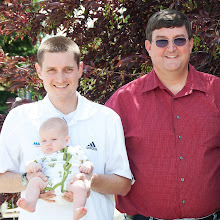I suppose most photographers already get that to freeze motion in a picture like this you must use a fast shutter speed. In this case I cranked the ISO up to 6400, put on my low light prime lens and took the shot at one five hundredth of a second.
There is another technique where you can use shutter speed for on the other end of the scale - showing motion.
Last weekend Michelle and I went out on a photo expedition. We were taking pictures of a windmill (see Photography Lesson #1 - The Magic 15). While we were shooting a very gentle breeze was blowing. The blades on the windmill were lazily turning at a speed of maybe a single revolution every half minute to a minute. By shooting a picture of them with a 1/125th shutter speed all motion was gone:

I then decided I wanted a picture that showed some blade motion. To do this I needed a much slower shutter speed. As it turned out, there was far too much light during the bright part of the day to get the effect I wanted. In a situation like this you could use a .9 neutral density filter which does not change any of the colors but adds 4 f-stops of "darkness" to the picture. Using such a filter would have allowed the shutter speed I needed but in this case I didn't have one so I had to wait until the sun was starting to set (and there was less direct sunlight).
As you can see from this picture, changing the shutter speed to a tenth of a second gives the impression that the blades are turning. I hand held the camera for the 1/125th exposure above but needed a tripod to shoot the tenth of a second shutter speed.
Increasing the time the aperture is open will suggest even more motion. In this final picture, the shutter speed is twice as long (1/5th second) as it is in the picture above:







No comments:
Post a Comment